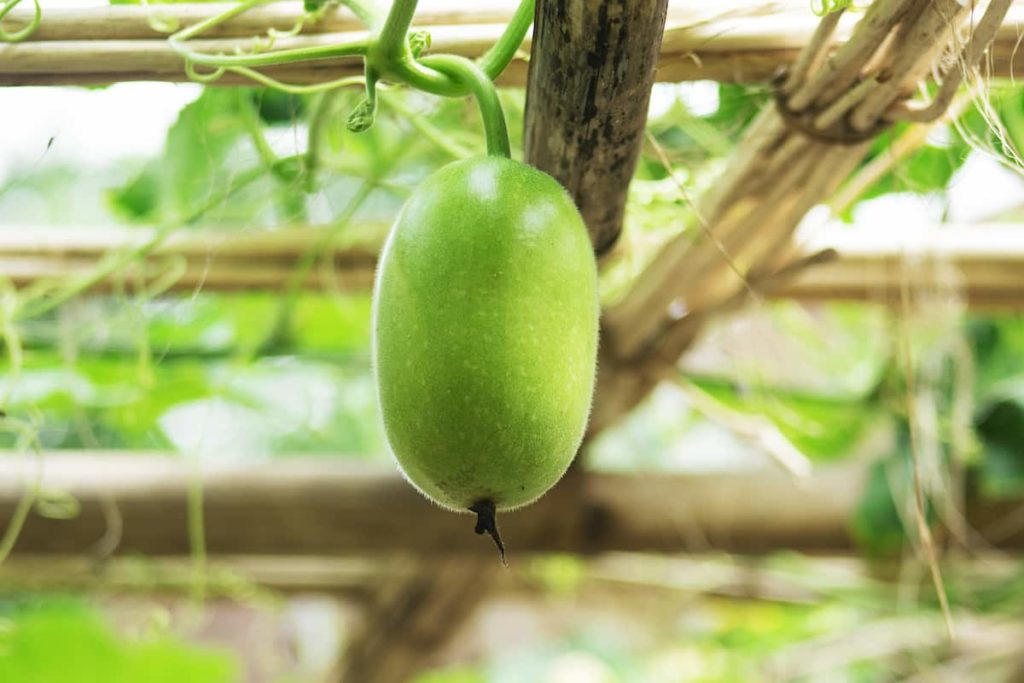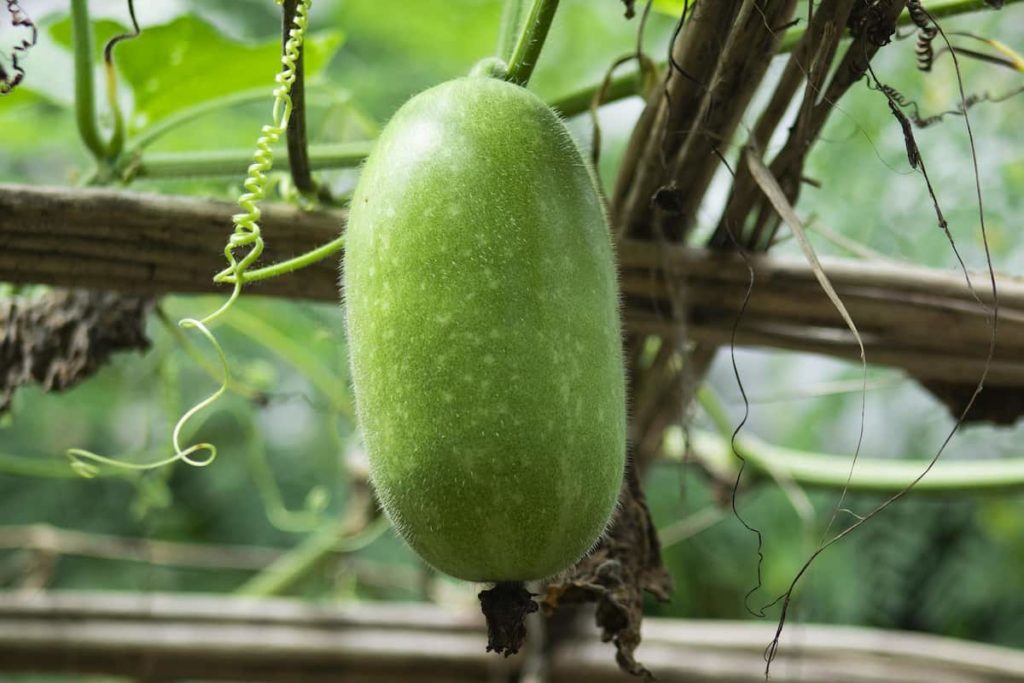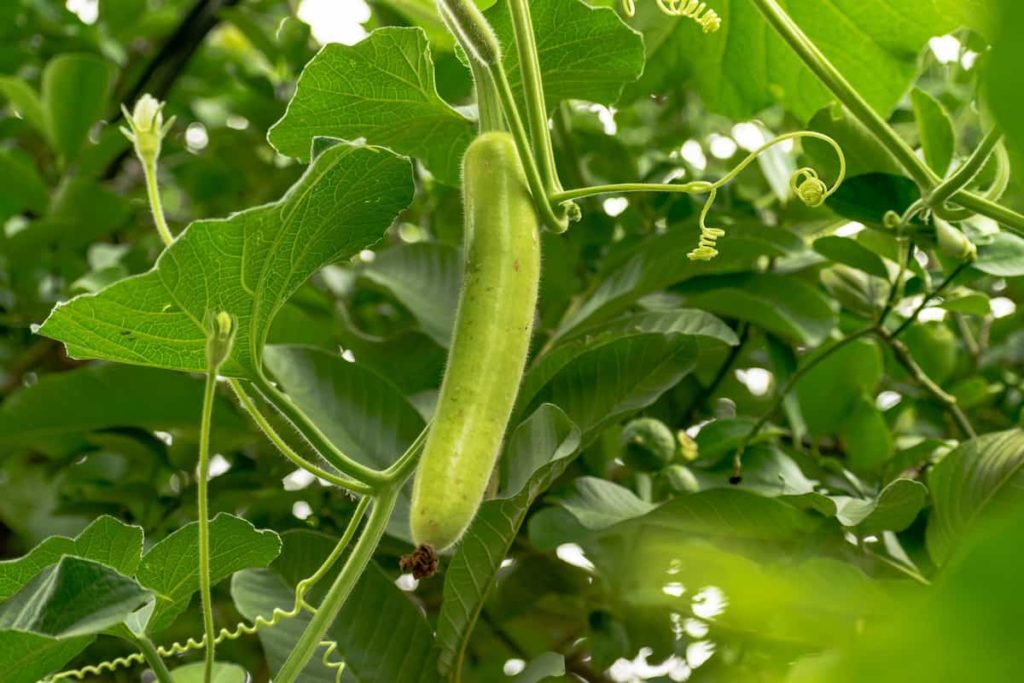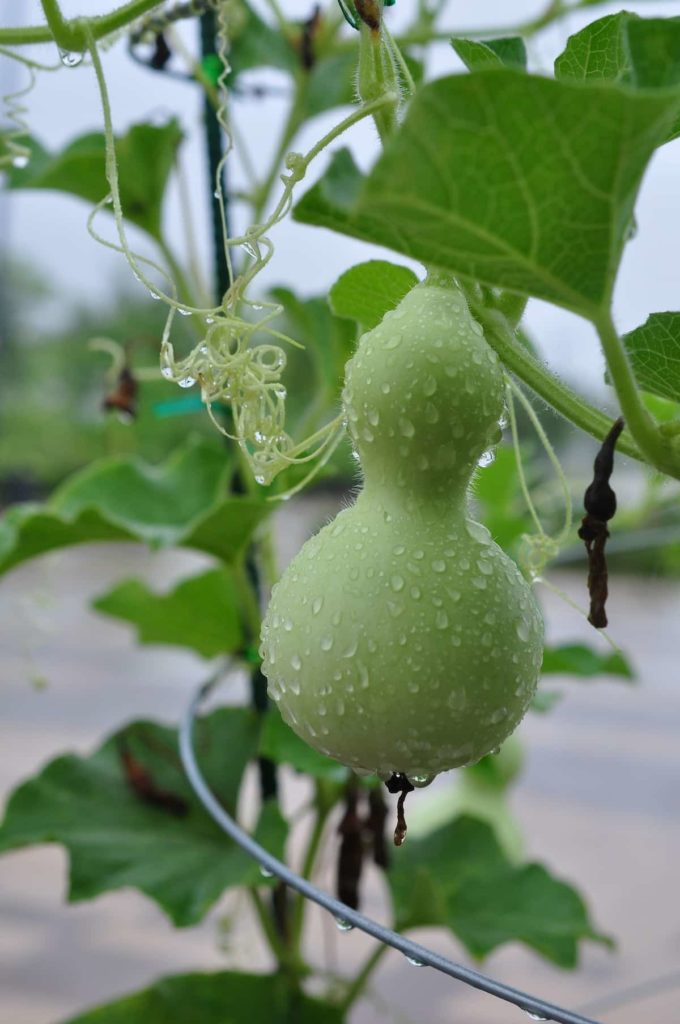Gourd, like many vegetables, grows best in full sun and well-drained soil. You should plant all types of Gourds in an area where they receive at least 8 hours of sunlight daily. A trellis, fence, or teepee is also helpful in preventing plants from spreading over considerable lengths and into a garden or lawn. You should build a strong trellis because Gourd is heavy when matured. Let’s check out how to build trellis for gourds below.

Bottle, swan Gourds, Luffa, and many other Gourd species grow on vines that benefit from supporting strong trellis or other structures. Gourd vines have a habit of great growth and take up much space in the garden, so it’s a good idea to grow the Gourd vertically if you have a small garden. You can maximize space in your garden with a trellis.
Gourds require additional support that a trellis can provide, and others, such as melons and squash, don’t need a trellis but can benefit from being lifted from the ground. When fruits are suspended from the trellis, they are less prone to disease, and plants can grow vertically rather than spread. Gourds can easily be trained to grow trellis, fences, or pergolas, making them an attractive addition to vertical gardens.
How to build trellis for gourds
Difference between a vertically grown Gourd and a horizontally grown Gourd
When the Gourd is grown vertically rather than horizontally, the Gourd hangs on the vine instead of sitting on the ground. This prevents Gourds from having a flat bottom where they sit on the ground. They are more tea drop shaped with a straight neck and rounded bottom. As vertical Gourd grows, especially in smaller spaces, vines are organized more than they grow horizontally in the field. This means that vines have fewer Gourds, but those that grow tend to grow larger, stronger, and develop earlier.
This is because fewer Gourds will be allowed to develop as soon as the vine is trimmed, and often vine ends will be trimmed to prevent any late-season Gourds from starting. To ensure the quality of your Gourds, you should hang them on a trellis. A trellis also saves space by keeping Gourds and vines away from the ground. Trellis made for growing Gourd must be firmly and safely anchored to the ground.
In case you missed it: How to Build a Trellis for Cucumbers: A Step-by-Step Planting Guide for Beginners

How to grow Gourds vertically
Gourds need full sunlight if you’re growing outdoors. As you know, Gourds are vines that spread, so they need space to grow. Gourd plants need a suitable place to give you healthy fruits. Planting Gourd seeds at least 8 to 10 feet is advisable. This will give sufficient space to grow and prevent your plants from diseases. Gourd plants can tolerate light frosts, but it is better to wait until the last frost passes, and the soil warms up before you plant your seeds.
You can also start the seeds indoors in early spring and transplant them into the garden when the risk of frost is over. Prepare the soil before planting some aged compost by digging it into the soil. Plant the Gourd seeds about an inch deep near the trellis or climbing structures you have selected to support the vines. If you have a small trellis or arches, you’ll probably only need a plant because vines can grow 16 feet or more, depending on the variety.
The seeds should start sprouting in about one to three weeks, but it may take longer if the soil is cold. Gourd plants produce long tendrils that wrap around trellis, fences, pergolas, and other vertical structures to help them climb. You can train plants to move upwards as plants grow by wrapping tendrils around a trellis or wire. If the plants start growing trellis, you can trim the vines back to fit the space.
Trellis height for growing gourds
Depending on the height of your Gourds at maturity, you should decide the height of your trellis. If you want to provide a growing height of more than 6 feet for plants, you may want to use a lean, A-frame, or arc trellis for support. A 6-foot-long trellis will be high enough to support most plants. Anything over 6 feet long can rotate and hang down as it grows.
If you make the trellis too long, it will be difficult for you to harvest anything more than 6 feet high. You can always use the ladder for harvesting, but you wouldn’t risk a broken arm or leg for some plants. It’s a better idea to choose your type of trellis wisely.
In case you missed it: Trellising and Staking Benefits for Plants in Your Garden
Gourds trellis ideas
Chicken Wire A-Frame
To make a chicken wire A-frame trellis, make two frames with long legs from untreated cedar. Staple the chicken wire to the frame, and use the hinge to attach the top two frames. This construction allows for width flexibility in the garden and flat winter storage. It’s also a good trellis for peas, small Pole Beans, and vining flowers.
Bamboo and Twine
Bamboo stakes around the garden are handy, and all trellis systems can be built with stakes and twines. Make a teepee by installing multiple stakes in a circle, then pair the top with the twine. Or, create a long wall by making two lines of poles at a distance of one foot and tying the top together. Place a stake vertically above the poles to add stability. The bamboo trellis works well with poles, runner Beans, and other tightly twining climbers.
T-Posts and Twine
Best for decorative cucumbers and small melons. This experimental trellis system is used to display Cucumbers and small Melons. Install multiple T posts in two rows, with T posts leaning outwards to create a V shape. Tie between each pair of T posts to complete each line of V. Place the plants where the T posts combine. The fruits will hang in the opposite direction of the V decoratively.
In case you missed it: Cheap Garden Trellises, Tips, Ideas, and Techniques

Metal Arch
A metal arch will enhance the beauty of your garden, while vining vegetables like Gourds will provide vital support.
Fence
You can leave Gourds to spread their long vines in all directions, but you can also train them on your garden or yard fence. You can easily harvest the fruit when needed; your fruits won’t become the dinner of pests. The trellis is a perfect structure for providing better support to any vine. In addition, to a trellis, you can also use a strong chain link fence to support Gourd vines. Vines become attractive when they weave through links.
If you plan to grow Gourds on fencing from hills or mounds, from the hill, you should leave at least 15 feet of space in each direction so each plant will get a 30-foot fence. You can create a complete bushy plant by pinching the tip of each important stem. Remember, Gourds never grow from the central stem, but they grow on the side branches.
Wire mesh trellis
Many types of trellis can be made with wire mesh panels. You should attach a five-foot-long wooden stake behind raised beds to support four by eight panels of concrete reinforced sturdy mesh panels. The panels are zippers attached to wood stakes. These constructed trellises hold heavy crops like snake Gourds that bear five to six feet long fruit. You can also use them to grow Cucumbers, Pole Beans, Runner Beans, and Peas.
Arbors, arches, and tunnels
You can grow various vegetables in tunnels and plenty of climbing flowers. To support Gourds Between raised beds or at the entrance to a vegetable garden, you can also add beautiful garden arches and arbors.
Pergolas
You can make pergolas in different shapes and sizes using different materials of wood or metal. Most use easy-to-buy and inexpensive wood that can be treated or painted. Gourds have large leaves and form a lovely shade when they reach the top of the pergola and move across it. They produce fun fruits to watch growing and are also a great product to work with after harvesting.
In case you missed it: How to Get Rid of Bugs on Indoor Plants: Simple Tips, Ideas, and Techniques

Although annual, they are easy to grow and remove once they mature on the pergola. Gourds love the heat and will grow well in a warm summer climate. They don’t need large amounts of water, but it’s good to water them, especially if the weather becomes excessively dry.
How to hang a Gourds on Trellis
First, you should dig a hole about 2 feet deep and place it 8 feet long by four wooden posts. Fill the hole, and pack the soil tightly around the post, so it’s secure. You can add as many posts as your garden space allows, but you should keep them at intervals of 4 feet. Place the first post several inches from any nearby structure to allow good airflow, preventing your Gourd from fungal infections. You should place the fence vertically at the base of the first post from top to bottom. Stretch the wire until you reach the next post, and staple it.
Continue unrolling and stapling the wire in subsequent posts until you arrive at the last post. Staple the wire to the last post, and then bring the wire around the post and unroll it in the opposite direction to the other side. Repeat fencing on each post until you return to the first post. At this point, you should run the wire on both sides of the bottom of your posts. Plant your Gourds according to the different types of recommendations you have. Large Gourds need much space to grow, but about 2 to 3 feet of space is needed between small to medium-sized vines.
Monitor the development of your Gourds. When long enough to work with vines, if the Gourd doesn’t climb the wiring naturally, you should tie the vines loosely using a nylon hose or old cotton fabric strips. Continue tying the vines upwards as needed until they run over and over the top of the wire fence. Support Gourds properly as they begin to grow if they are likely to weigh more than 1.3 kg. You should not tie the sling too tightly; you risk injuring the vines, making them vulnerable to pests and disease.
In case you missed it: Garden Trellis – Types, Ideas, Design, And Tips

Conclusion
Many sizes of Gourd have been grown on this trellis for many years. It varies seasonally, from bushel and dipper Gourds to birdhouse Gourds and small decorative Gourds. It’s fun to watch Gourd grow throughout the season, some hanging from above through the overhead trellis, others sitting on top, yet hanging more along the sides.
- How to Grow Tomatoes Organically at Home: A Comprehensive Guide
- Organic Gardening on a Budget: Low-Cost Methods and Materials
- Gongura Seed Germination and Planting Methods
- Cabbage Seed Germination and Selection
- Broccoli Seed Germination and Selection
- Asparagus Seed Germination and Variety Selection
- Seasonal Flower Gardening: Best Practices for Spring, Summer, Fall, and Winter
- How to Grow Hibiscus from Flower
- Plantation Ideas for Home Decoration: A Beginners Guide
- Flower Garden Designs and Layouts for Beginners
- Planting and Spacing Techniques in Papaya: A Beginner’s Guide
- Growing Gold: Essential Techniques for Planting Pineapples
- How to Make Kalanchoe Plant Bushy: Home Remedies and Solutions
- 11 Reasons Why Your Gardenia is Not Blooming: Home Remedies and Solutions
- Eco Elegance: The Guide to Designing a Drought-Tolerant Landscape
- Gardening on a Slope: Strategies for Hillside Landscaping
- Nourish and Flourish: Top Organic Mulches for Thriving House Plants
- Everything You Want to Know about Indian Mogra Flower: Discover Uses and Growing
- Green Thumb Success: Expert Tips for Cultivating Greenhouse Pumpkins All Year Round
- Maximize Growth & Flavor: The Ultimate Guide to Companion Planting in Herb Gardens
- How to Control Rhododendron Problems Naturally: Home Remedies and Organic Ways to Fix Them
- Natural Magic: The Remarkable Benefits of Cinnamon for Plants
- Best Steps to Revive Dying Tulip with Natural and Organic Treatment
- 10 Reasons Why Your Angel Trumpet is Not Blooming: Remedies and Treatment
- How to Fix Periwinkle Leaf and Flower-Related Problems: Natural Remedies and Solutions
- How to Fix Zinnias Leaf and Flower Problems: Discover Natural and Home Remedies
- Organic Steps to Induce Lemon Tree Flowers: A Comprehensive Guide
- Bloom Booster: Crafting the Perfect Homemade Bougainvillea Fertilizer
- Optimizing Growth: A Guide to Applying NPK Fertilizer for Potted Plants
- 10 Best Homemade Fertilizers for Rubber Plant: DIY Recipes and Application Method
- How to Boost Female Pumpkin Flowers: Effective Steps for More Flowers and High Yields
- Transform Your Indoor Garden: Top Benefits of Pink Salt for Houseplants
- 10 Best Homemade Fertilizers for Peacock Plants (Calathea): Easy DIY Guide
- Unlock Blooms: 9 Reasons Why Your Potted Chrysanthemum is Not Blooming
- 8 Reasons Why Your Potted Hibiscus is Not Blooming: Fix it with Simple Solutions
- Unlock Blooms: 9 Key Reasons Your Potted Frangipani Won’t Flower
